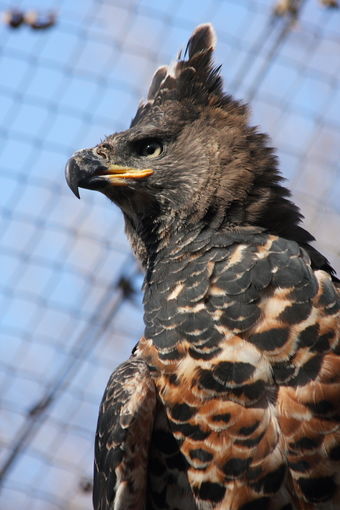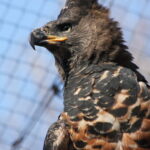The Crowned Eagle (Stephanoaetus coronatus) is a powerful bird of prey endemic to the African continent. Its preferred habitats are principally riparian woodlands and various forests, including those deep within the rainforest, relict patches, wooded escarpments, riparian strips of Acacia, heavily wooded hillsides, and rocky outcrops throughout its range. The eagle may be found from an altitude of sea-level to at least 3,000 m (9,800 ft).
The Crowned Eagle’s Preferred Habitats
The Crowned Eagle’s habitat preferences can be summarized as follows:
| Habitat Type | Description |
|---|---|
| Riparian Woodlands | Forests and woodlands found along rivers and streams |
| Rainforests | Dense, lush forests found in tropical regions |
| Relict Patches | Isolated, remnant forest areas |
| Wooded Escarpments | Forested, steep slopes or cliffs |
| Acacia Riparian Strips | Narrow, wooded areas along rivers and streams dominated by Acacia trees |
| Wooded Hillsides | Forested, hilly terrain |
| Rocky Outcrops | Exposed, rocky areas within forested environments |
The Crowned Eagle’s habitat range extends from central Ethiopia to eastern South Africa in East Africa, and from Senegal to Angola in West and Central Africa. Despite its large distribution, the species is now rare in many parts of West Africa due to habitat loss and degradation.
Factors Influencing the Crowned Eagle’s Habitat Selection
The Crowned Eagle’s habitat preferences are influenced by several key factors:
-
Prey Availability: The eagle’s diet consists primarily of small to medium-sized mammals, such as monkeys, hares, and small antelopes. Forested habitats with abundant prey populations are essential for the Crowned Eagle’s survival.
-
Nesting Requirements: Crowned Eagles build large, stick nests high up in the canopy of tall trees, often in the forks of branches. Mature, undisturbed forests with suitable nesting sites are crucial for the species.
-
Disturbance Levels: Crowned Eagles are sensitive to human disturbance and tend to avoid areas with high levels of human activity, such as agricultural lands or urban areas.
-
Altitude Range: The Crowned Eagle can be found from sea level up to an altitude of 3,000 m (9,800 ft), allowing it to inhabit a wide range of forested environments.
Threats to the Crowned Eagle’s Habitat
The Crowned Eagle’s habitat is under threat from several human-induced factors:
-
Deforestation: The almost epidemic destruction of the native tropical African forest, which is a major target of timber companies, agriculturists, palm oil and biofuel plantations, and miners, as well as slash-and-burn farmers, is a significant threat to the Crowned Eagle’s habitat.
-
Habitat Fragmentation: The conversion of continuous forest landscapes into smaller, isolated patches can disrupt the Crowned Eagle’s breeding and foraging activities, making it more vulnerable to predation and other threats.
-
Persecution: Crowned Eagles are sometimes persecuted due to their size, reputation, and potential for taking small livestock. They are often shot, trapped, or have their nests destroyed by humans.
-
Climate Change: Alterations in temperature and precipitation patterns due to climate change may also impact the Crowned Eagle’s habitat and prey availability in the future.
Conservation Efforts
To protect the Crowned Eagle and its habitat, several conservation efforts are underway:
-
Protected Areas: Establishing and maintaining a network of protected areas, such as national parks and nature reserves, can help safeguard the Crowned Eagle’s habitat.
-
Habitat Restoration: Reforestation and habitat restoration projects can help rebuild and reconnect fragmented forest landscapes, providing more suitable habitat for the Crowned Eagle.
-
Community Engagement: Engaging local communities in conservation efforts, such as education and awareness programs, can help reduce persecution and promote the protection of the Crowned Eagle and its habitat.
-
Research and Monitoring: Continued research and monitoring of the Crowned Eagle’s population and habitat status can inform conservation strategies and guide management decisions.
By understanding the Crowned Eagle’s habitat preferences and the threats it faces, we can work to protect this majestic bird of prey and the diverse ecosystems it calls home.


